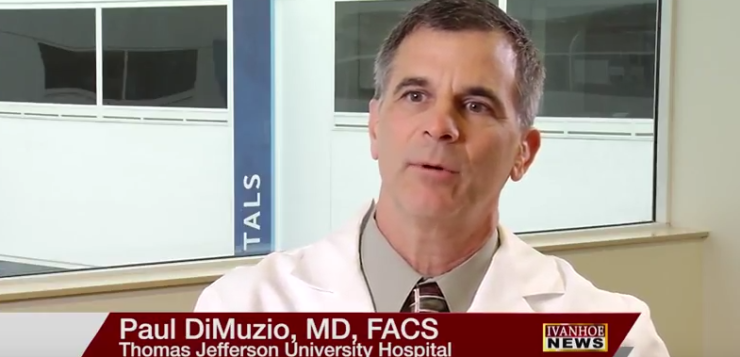Paul DiMuzio, MD, FACS, William M. Measey Professor of Surgery and Director, Division of Vascular and Endovascular Surgery at Thomas Jefferson University Hospital, discusses a new treatment option for patients with clogged carotid arteries.
Interview conducted by Ivanhoe Broadcast News June 2017.
So you are working on a procedure that actually clears the carotid artery, or at least allows more blood flow to go through, could you explain that just a little bit?
Dr. DiMuzio: One of the causes of stroke is plaque inside someone’s carotid artery, which is the artery that feeds the brain, and traditionally people are treated by removing it in a procedure called carotid endarterectomy. An alternative is carotid artery stenting, but that is not always safe in certain circumstances. TCAR is a new procedure that is a hybrid between endarterectomy and traditional stenting. Under local anesthesia through a small incision above the clavical, we deliver a stent inside the plaque to open up the artery and get more blood flow to the brain.
Could you explain why would it be more difficult to stent the carotid, if people are familiar with the heart getting stented?
Dr. DiMuzio: The traditional way to stent a carotid is through a puncture in the groin, and to get all the way to the carotid we would have to cross the area of the aortic arch and in doing so that could potentially cause a stroke. This is especially true in people of advance age, over the age of 75 or 80 years old. The new procedure establishes access to the carotid directly just above the claviclewithout having to cross the aortic arch.
The progressive part of this is for somebody who needed the stent and had to undergo the transfermal, they could have had a stroke?
Dr. DiMuzio: The purpose of carotid intervention is to prevent stroke; however, any manipulation of the carotid circulation can cause an unintended stroke.
So this is such a great step in the right direction and how noninvasive is it just going through the carotid?
Dr. DiMuzio: The TCAR procedure is not as invasive as a standard carotid endarterectomy, which is typically a two inch incision high in the neck. We perform TCAR completely under local anesthesia, and the patient remains completely awake. This gives us confidence that things are going well during the procedure, and the patient recovery is significantly easier not having undergone general anesthesia.
How long have you being doing this and how long has TJ been doing this?
Dr. DiMuzio: The procedure was pioneered two to three years ago, it went through pivotal testing and the FDA approved it last year. The SilkRoad Company is now performing a clinical trial of 30 centers in the country one of which is Jefferson. We started the trial with them about six months ago; so far they have enrolled about three hundred patients for their goal of six hundred patients.
And how many procedures have you done with this?
Dr. DiMuzio: We have performed over a dozen now with excellent success.
And you as a surgeon, how is this different for you, easier? You must feel more confident because you know that you do not have to go through all the aortic heart?
Dr. DiMuzio: The procedure is still technically demanding, requiring significant attention to detail.We have to be very careful not to cause any dislodgement of plaque, but the way it protects the brain–flow reversal—allows us to deploy the stentwith confidence, and the stroke rates are extremely low compared to the standard.
People who have problems with their hearts though, do they generally have carotids blocked or is that related at all?
Dr. DiMuzio: and the plaques are from a disease called atherosclerosis. This can affect carotids, causing stroke; the coronary artery, which causes heart attacks; as well as the legs, which can cause conditions such as pain with walking and gangrene.
So how do people recognize that they might be having problems, number one, and part two is what are their symptoms of stroke as it is happening?
Dr. DiMuzio: The vast majority of patients do not know they have plaques in their carotid arteries and it can be picked up by physical examination. Often times their family doctor will listen right where their carotids are and hear a sound that will indicate performing an ultrasound which is a minimal invasive test. If the blockage is greater than 70 percent, the patient would be considered for repair to prevent a stroke. Additionally, if the patient has signs/symptoms of a stroke, or even a mini stroke; which could be a change in vision, change in speech, or weakness in one side of the body, or they would be worked up in a similar fashion. casein such a situation, we would generally treat the carotid artery with a blockage that is 50 percent or greater.
Is this an older age condition or do younger people have it as well?
Dr. DiMuzio: Typically, as we age, weare prone to developing atherosclerosis, so usually patients are in their 70’s and 80’s.
I hear so much about young children and teenagers with obesity and I just wondered that if you are seeing more younger patients come in with this; it probably takes time to build that up?
Dr. DiMuzio: It takes time for plaque to build up, and we do see patients as young as 40 or 50 years old. Prevention involves modification of the risk factors including no smoking, and controlling diabetes, hypertension, and elivated lipids in the blood.
How important is this particular procedure and how much of an improvement is it just in a general way, for you?
Dr. DiMuzio: In general I think it will be a game changer particularly for patients who are in need of carotid repair but are perhaps too ill to undergo standard carotid surgery. I think it is a very significant improvement in the way we treat patients with this disease.
Are there other places around the country that are doing this?
Dr. DiMuzio: Yes, we are one of the thirty centers in the country and right now the only one in the Philadelphia area doing it.
END OF INTERVIEW
This information is intended for additional research purposes only. It is not to be used as a prescription or advice from Ivanhoe Broadcast News, Inc. or any medical professional interviewed. Ivanhoe Broadcast News, Inc. assumes no responsibility for the depth or accuracy of physician statements. Procedures or medicines apply to different people and medical factors; always consult your physician on medical matters.
If you would like more information, please contact:
The Thomas Jefferson Angioplasty and Vascular Center
215-955-8304
Sign up for a free weekly e-mail on Medical Breakthroughs called First to Know by clicking here.




